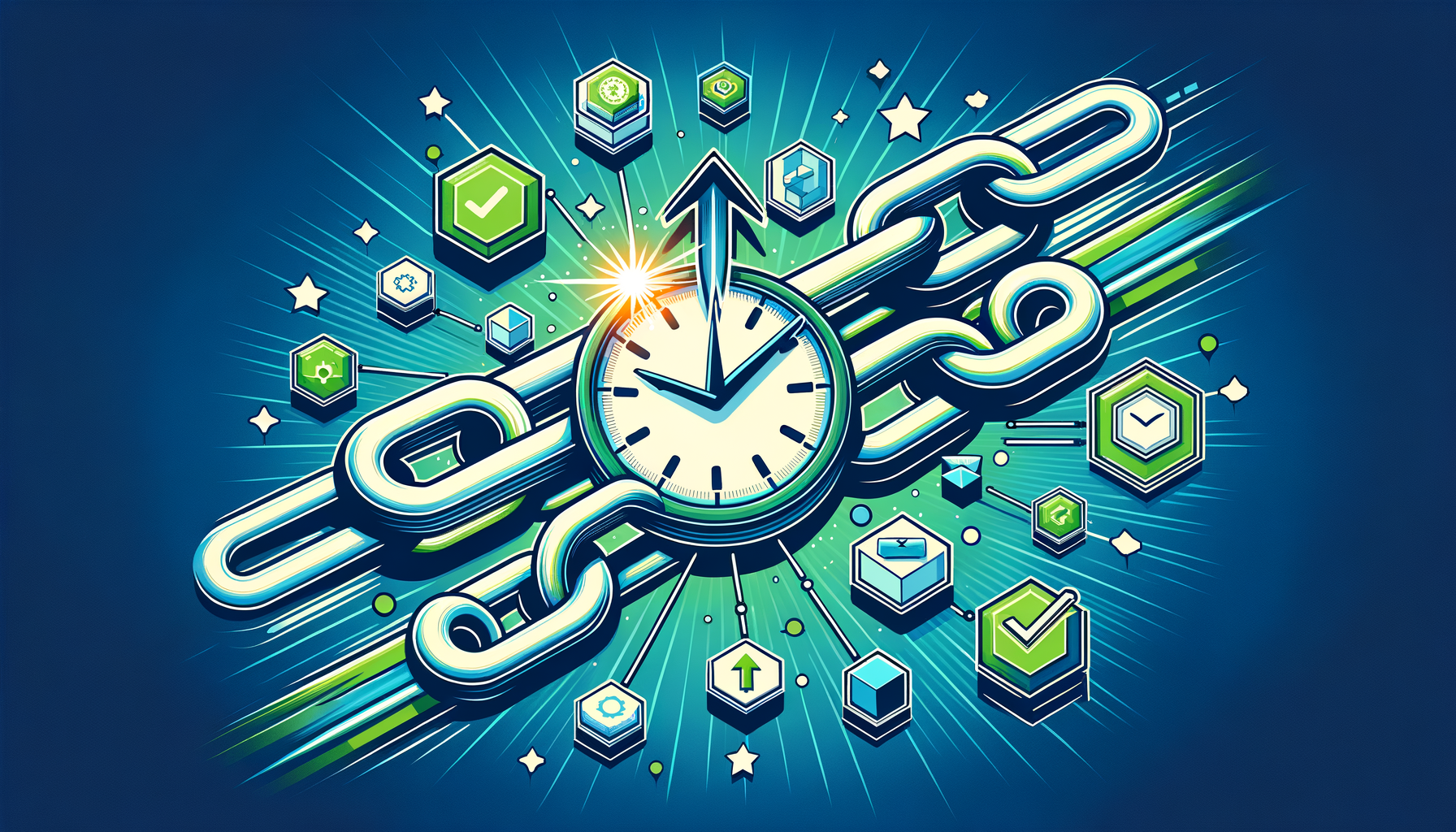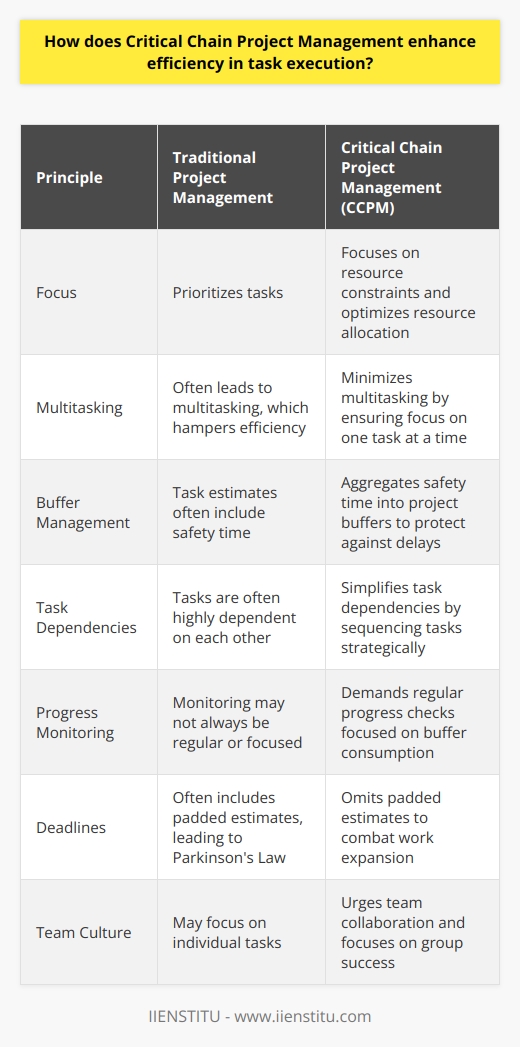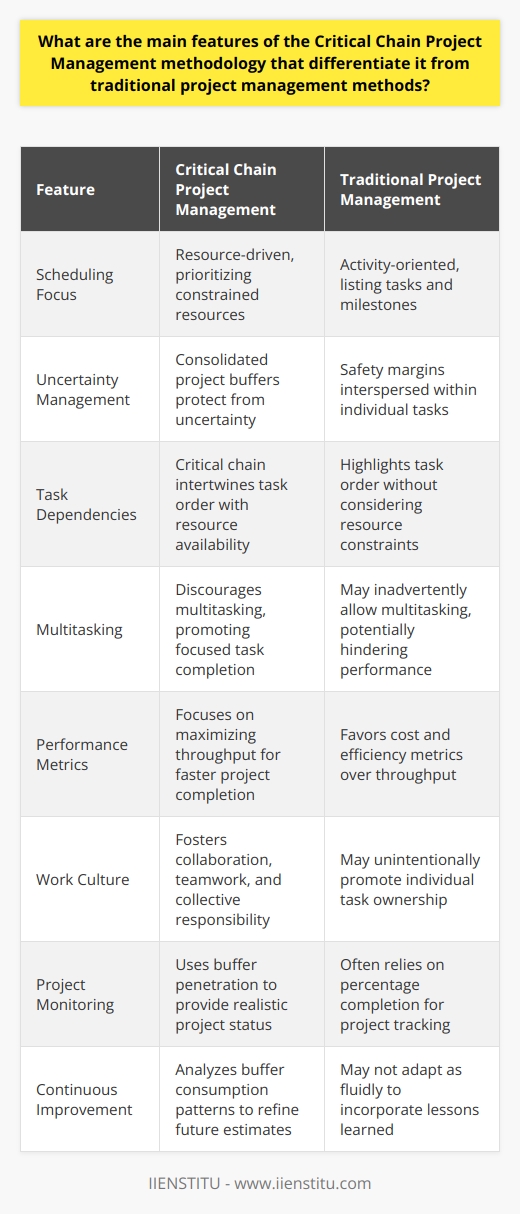
Critical Chain Project Management (CCPM) represents a significant evolution in the realm of project management methodologies. By focusing on the optimization of resources and considering the uncertainties inherent in project execution, CCPM stands as an invaluable tool for project managers seeking enhanced efficiency and reliability in task completion. While traditional project management techniques have centered on sequential task completion, CCPM revolutionizes this approach by introducing a more flexible and strategic framework.
At the heart of Critical Chain Project Management is the recognition of the crucial constraint-based pathway that has the potential to significantly affect the duration and success of a project. Moreover, CCPM emphasizes the importance of resource availability and the management of buffers, which serve to address variability and ensure project timelines remain feasible. Understanding the historical context and development of CCPM is essential in appreciating its present-day application and effectiveness across various industries.
Understanding the Basics of Critical Chain Project Management
Theory of Constraints
Problem solving training often starts with a foundation in the Theory of Constraints (TOC), a paradigm that posits that any manageable system is limited in achieving its goals by a very small number of constraints. CCPM applies the principles of TOC by identifying the project's critical chain, which is the sequence of tasks that determines the project's duration, and applying resources to remove the constraint and expedite the process.
The relevance of TOC in CCPM lies in its focus on strategic resource management. By concentrating effort and resources on the critical chain, project managers can effectively drive project progress and preempt potential delays. This application serves to optimize the overall workflow and maximize the utilization of available resources within the project lifecycle.
Buffers in Critical Chain Project Management
Buffers are pivotal to the Critical Chain methodology's ability to manage uncertainties. CCPM categorizes buffers into three main types: project buffers, feeding buffers, and resource buffers. A project buffer is placed at the end of the critical chain to accommodate any slippage along the path. Feeding buffers protect the critical chain from delays in tasks that feed into it, and resource buffers ensure that critical resources are available when needed.
The role of buffers is to absorb the variability inherent in project execution, preventing this variability from causing project overruns. Through effective buffer management, CCPM provides a cushion against the impacts of unforeseen events, ensuring that the project remains on track and stakeholders can anticipate reliable project delivery times.
Differentiating Critical Chain from Critical Path
Breaking Down Complex Problems: Developing Problem Solving Skills
Decision Tree: A Strategic Approach for Effective Decision Making
SWOT Analysis Matrix: Comprehensive Guide to Strategic Decision Making
The Critical Path Method (CPM) has been used in project management for decades, representing a sequence of stages where any delay would subsequently delay the entire project. The Critical Path, however, does not account for resource constraints, which can be a major oversight, especially in complex and resource-driven projects.
An overview of the differences between the Critical Chain and the Critical Path reveals that while both methodologies aim to determine the minimum project duration, CCPM's inclusion of resource constraints and buffer management provides a more robust and dynamic approach to project planning and execution. The similarities lie in their shared objective to streamline project delivery, but the application of buffers and attention to resource management in CCPM distinguishes it as a more adaptive and effective model.
Implementing Critical Chain Project Management
Steps in Applying CCPM
To implement CCPM effectively, a series of structured steps are followed. Initially, the project work breakdown structure is created, identifying all tasks required to complete the project. The next step involves determining the critical chain by accounting for task dependencies and resource constraints, followed by an estimation of task durations with an embedded safety margin that are aggregated into project buffers.
An example of each step's application may involve constructing a new software development project's critical chain. The manager would begin by breaking down the software creation process into individual tasks, determine which tasks are dependent on others, factor in personnel and technical resource availability, and then estimate how long each task should take with a safety margin that is later consolidated into the project buffer.
Tools and Techniques for CCPM implementation
Several tools aid in the implementation of CCPM, including specialized project management software that can identify and track the critical chain, manage buffers, and monitor project progress with an eye on resource optimization. Moreover, visual management techniques, such as Gantt charts enhanced for CCPM, enable the clear presentation of project timelines and buffer status.
Techniques used to optimize CCPM include constant monitoring of buffer usage to identify whether project segments are consuming buffer time too quickly, thus signaling potential problems before they imperil the project's deadline. In practice, these tools and techniques offer project managers the means to steer CCPM-driven projects toward successful completion, adjusting and optimizing as necessary along the way.
Role of team members in CCPM implementation
Individual roles in a project utilizing CCPM are clear and generally focused on throughputs instead of individual task completion times. Each team member is responsible not only for their assigned tasks but also for working collaboratively to ensure that resources are utilized efficiently and the critical chain progresses without bottleneck.
For instance, a team member may be required to switch to a different task to alleviate a resource constraint on the critical chain. This approach highlights the collective contribution to the project's success and how each member can contribute to the robustness of the CCPM by flexible resource assignment and active engagement in buffer management.
Advantages and Limitations of Critical Chain Project Management
Benefits of using CCPM
The benefits of using CCPM in project management are far-reaching and substantial. By accounting for resource constraints and incorporating buffer management, projects often experience a significant reduction in overall project duration. Additionally, CCPM's focus on the delivery of project milestones, rather than individual task completion, typically results in more efficient resource distribution, allowing teams to adapt dynamically to project demands.
Testimonials and case studies underscore CCPM's success in various sectors, from construction to software development. These real-world applications and success stories provide evidence of CCPM's effectiveness, demonstrating how organizations have realized shorter project durations, improved on-time delivery rates, and optimized resource allocation, leading to increased client satisfaction and a stronger competitive edge.
Drawbacks of CCPM
While CCPM offers numerous advantages, it is not without potential limitations. For one, the radical shift in management philosophy that CCPM requires can lead to resistance within organizations accustomed to traditional project management approaches. The methodology's reliance on team flexibility and dynamism can also pose challenges in rigid environments that are less adaptable to change.
Real-life examples exist where the challenges faced in CCPM implementation include the underutilization of buffers due to poorly calibrated estimations and difficulties in changing corporate culture to fully embrace the principles of the methodology. Such occurrences illustrate that while CCPM is a powerful tool, its success is contingent upon proper understanding, implementation, and cultural compatibility within the organization.
In revisiting the principles and execution of Critical Chain Project Management, it is crucial to recognize its unique role in modern project delivery. The methodology emphasizes a pragmatic approach to managing projects, prioritizing constraint identification and resource optimization in a dynamic and uncertain project environment.
Its importance extends beyond theoretical interest; it evokes a paradigm shift that demands an appreciation of the finite nature of resources and the need for risk mitigation through strategic planning and buffer allocation. Lastly, as organizational landscapes and project demands continually evolve, so too must methodologies like CCPM adapt, potentially signifying future developments in its theoretical foundation and practical application.
Frequently Asked Questions
How does Critical Chain Project Management enhance efficiency in task execution?
Critical Chain Project Management Principles
Critical Chain Project Management (CCPM) seeks efficiency. It differs from traditional models. CCPM focuses on resources. Traditional methods prioritize tasks. CCPM raises efficiency in several ways.
Focus on Resource Constraints
CCPM targets resource efficiency. It optimizes resource allocation. Projects often face limited resources. CCPM identifies critical resources. It then schedules tasks around these resources.
Reduction of Multitasking
Multitasking hampers efficiency. CCPM minimizes this issue. It ensures focus on one task. This reduces context-switching overhead. Work progresses faster.
Buffer Management
CCPM introduces project buffers. These are periods of extra time. They protect the execution against delays. Task estimates often include safety time. CCPM aggregates this safety into buffers. Thus, buffers enhance task execution management.
Task Dependency Reduction
Tasks depend on each other in projects. CCPM simplifies these dependencies. It sequences tasks strategically. Tasks flow smoothly. This reduces bottleneck creation.
Progress Monitoring
CCPM demands regular progress checks. These checks focus on buffer consumption. They ensure the project remains on track. Teams can adjust promptly. Monitoring prevents unnecessary delays.
CCPM Improves Task Execution
Task execution under CCPM follows a thoughtful approach. Efficiency is the hallmark of this method.
Elimination of Artificial Deadlines
CCPM omits padded estimates. Traditional methods include them. This leads to Parkinson’s Law. It states work expands to fill the time available. CCPM combats this.
Promoting a Collaborative Culture
CCPM urges team collaboration. It does not focus on individual tasks. Group success becomes the goal. Collaboration leads to faster problem-solving.
Enhancing Priority Setting
Clear priorities guide CCPM. Teams understand what matters most. Priorities cut through the confusion. They streamline task execution.
Increasing Project Visibility
CCPM enhances project transparency. This visibility aids decision-making. Teams see the project status in real-time. They anticipate and solve problems early.
Facilitating Agile Response
CCPM allows for nimble adjustments. It provides the foundation for rapid response. Teams can react to changes swiftly. Efficiency does not suffer.
In conclusion, CCPM offers a robust framework. It makes task execution more efficient. It focuses on what truly drives project success. Resources receive the attention they require. Project buffers provide safety nets. Multitasking gets reduced. Prioritization becomes clearer. As a result, teams work smarter, not harder. CCPM might present a learning curve. Yet, its benefits in enhancing efficiency are clear. It positions projects for a higher success rate. Hence, CCPM stands out in the world of project management.

What are the main features of the Critical Chain Project Management methodology that differentiate it from traditional project management methods?
Critical Chain Project Management: A Distinct Approach
When discussing project management methodologies, Critical Chain Project Management (CCPM) often stands out. Unlike traditional methods, CCPM focuses on resource optimization and strategic buffering. This distinct approach reshapes how project timelines and resources receive management attention.
Resource-Driven Scheduling
CCPM prioritizes the most constrained resources. It is resource-focused, not activity-oriented. Traditional methods often list tasks and milestones. CCPM, however, first identifies critical resources. It then schedules tasks around their availability.
Project Buffers for Uncertainty
Buffers protect projects from uncertainty. CCPM does not intersperse buffers within tasks. Instead, it consolidates safety into dedicated project buffers. This ensures uninterrupted task execution and on-time project completion.
Task Dependencies and Critical Chain
Critical chain is the primary focus. It represents the sequence of tasks constrained by both dependencies and resources. Traditional methods highlight task order. CCPM intertwines such order with resource availability.
Reduced Multitasking
CCPM discourages multitasking. Research shows multitasking can hinder performance. Thus, CCPM promotes focused task completion, improving productivity and reducing burnout.
Dynamic Task Management
Task durations include safety margins in traditional planning. CCPM separates these margins from individual tasks. It creates a shared safety buffer. This allows for more aggressive task estimates and dynamic management.
Attention on Throughput
Throughput is the rate of production. CCPM aims to maximize it. Traditional methods favor cost and efficiency metrics. CCPM's focus on throughput can lead to faster project completion.
Change in Work Culture
CCPM can transform work culture. It encourages a collaborative approach to problem-solving. Traditional methods may inadvertently promote individual task ownership. CCPM fosters teamwork and collective responsibility.
Monitoring Project Health
CCPM uses buffer management to monitor project health. Traditional tracking often relies on percentage completion. Buffer penetration provides a more realistic project status in CCPM.
Continuous Improvement
CCPM supports continuous improvement. It learns from buffer consumption patterns. Traditional methods may not adapt as fluidly. CCPM analyzes buffers to refine future project estimates.
CCPM stands apart from traditional project management methodologies. It aligns closely with principles of efficiency, adaptability, and teamwork. It provides a robust framework for managing projects in uncertain environments. This method is not just about scheduling. It represents a comprehensive philosophy that re-envisions project management for better outcomes.

How does Critical Chain Project Management handle the uncertainties and risks that are often associated with complex projects?
Understanding Critical Chain Project Management (CCPM)
CCPM addresses project uncertainties innovatively. Developed by Eliyahu M. Goldratt, it enhances traditional project management. It focuses on resources, recognizing them as critical constraints. CCPM also emphasizes project buffers.
CCPM Response to Uncertainties and Risks
Projects entail uncertainties. CCPM manages these proactively. It combines planning with flexibility. It uses buffers to absorb variances. These buffers are time reserves. They exist at project and task levels.
- Project Buffer: Sits at the project end. It shields the delivery date.
- Feeding Buffer: Protects the critical chain. It is between non-critical tasks and the critical chain.
- Resource Buffer: Indicates to resources. It helps in transitions.
Buffers accumulate "safety" times. This practice differs from traditional methods. In those methods, tasks include individual safety margins. CCPM aggregates the margins. This strategy creates larger, central safety zones. Overall, project duration often shortens.
Risk Mitigation in CCPM
CCPM tackles the resource constraints problem. It optimizes their allocation. A Resource Buffer alerts resources to upcoming tasks. Team members become ready in advance.
The methodology encourages focus on task completion. Workers concentrate on singular tasks. This approach limits multitasking. Progress thus speeds up.
Task dependencies receive careful attention. The Critical Chain gets the spotlight. Project management software often helps in this area. It schedules and resynchronizes tasks.
CCPM's Behavioral Aspects
CCPM understands human behavior. It expects optimistic task estimates. Managers build buffers considering this tendency. Team members feel less pressured. Work quality improves.
The methodology fosters team collaboration. Projects become joint efforts. Each delay impacts collective buffers. Hence, teams work together to stay on track.
The Role of Monitoring and Reporting
Constant monitoring is key. Project managers must observe buffer consumption. They should react if consumption accelerates unexpectedly. Preparation for possible issues is crucial.
Reporting happens in real-time. Issues need quick addressing. CCPM provides greater situational awareness. Decisions become data-driven. Responses to risks occur faster.
CCPM's Continuous Improvement Cycle
Learning is part of CCPM. After project completion, teams review buffer usage. They understand the variance causes. Future buffer sizing improves. Knowledge gained guides future planning.
In conclusion, CCPM offers a robust approach to handle project uncertainties and risks. It deploys strategic buffers. It optimizes resource usage. Team behavior becomes focused. Monitoring and reporting emphasize quick adjustments. Continuous learning rounds out the approach. Thus, CCPM equips teams to tackle complex projects effectively.



